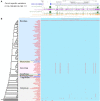RGD v2.0: a major update of the ruminant functional and evolutionary genomics database
- PMID: 34643708
- PMCID: PMC8728256
- DOI: 10.1093/nar/gkab887
RGD v2.0: a major update of the ruminant functional and evolutionary genomics database
Abstract
Ruminant Genome Database (RGD; http://animal.nwsuaf.edu.cn/RGD) provides visualization and analysis tools for ruminant comparative genomics and functional annotations. As more high-quality ruminant genome assemblies have become available, we have redesigned the user interface, integrated and expanded multi-omics data, and developed novel features to improve the database. The new version, RGD v2.0, houses 78 ruminant genomes; 110-species synteny alignments for major livestock (including cattle, sheep, goat) and wild ungulates; 21 012 orthologous gene clusters with Gene Ontology and pathway annotation; ∼8 600 000 conserved elements; and ∼1 000 000 cis-regulatory elements by utilizing 1053 epigenomic data sets. The transcriptome data in RGD v2.0 has nearly doubled, currently with 1936 RNA-seq data sets, and 155 174 phenotypic data sets have been newly added. New and updated features include: (i) The UCSC Genome Browser, BLAT, BLAST and Table Browser tools were updated for six available ruminant livestock species. (ii) The LiftOver tool was newly introduced into our browser to allow coordinate conversion between different ruminant assemblies. And (iii) tissue specificity index, tau, was calculated to facilitate batch screening of specifically expressed genes. The enhanced genome annotations and improved functionality in RGD v2.0 will be useful for study of genome evolution, environmental adaption, livestock breeding and biomedicine.
© The Author(s) 2021. Published by Oxford University Press on behalf of Nucleic Acids Research.
Figures



Similar articles
-
The UCSC genome browser database: update 2007.Nucleic Acids Res. 2007 Jan;35(Database issue):D668-73. doi: 10.1093/nar/gkl928. Epub 2006 Nov 16. Nucleic Acids Res. 2007. PMID: 17142222 Free PMC article.
-
Galbase: a comprehensive repository for integrating chicken multi-omics data.BMC Genomics. 2022 May 12;23(1):364. doi: 10.1186/s12864-022-08598-2. BMC Genomics. 2022. PMID: 35549894 Free PMC article.
-
Bovine Genome Database: new annotation tools for a new reference genome.Nucleic Acids Res. 2020 Jan 8;48(D1):D676-D681. doi: 10.1093/nar/gkz944. Nucleic Acids Res. 2020. PMID: 31647100 Free PMC article.
-
Genetic advancements and future directions in ruminant livestock breeding: from reference genomes to multiomics innovations.Sci China Life Sci. 2025 Apr;68(4):934-960. doi: 10.1007/s11427-024-2744-4. Epub 2024 Nov 26. Sci China Life Sci. 2025. PMID: 39609363 Review.
-
Exploring human disease using the Rat Genome Database.Dis Model Mech. 2016 Oct 1;9(10):1089-1095. doi: 10.1242/dmm.026021. Dis Model Mech. 2016. PMID: 27736745 Free PMC article. Review.
Cited by
-
InDel and CNV within the AKAP13 Gene Revealing Strong Associations with Growth Traits in Goat.Animals (Basel). 2023 Aug 29;13(17):2746. doi: 10.3390/ani13172746. Animals (Basel). 2023. PMID: 37685010 Free PMC article.
-
De novo transcriptome assembly database for 100 tissues from each of seven species of domestic herbivore.Sci Data. 2024 May 11;11(1):488. doi: 10.1038/s41597-024-03338-5. Sci Data. 2024. PMID: 38734729 Free PMC article.
-
A comparative review of short genetic variant databases across humans and animal species.Brief Bioinform. 2025 Jul 2;26(4):bbaf356. doi: 10.1093/bib/bbaf356. Brief Bioinform. 2025. PMID: 40736747 Free PMC article. Review.
-
IAnimal: a cross-species omics knowledgebase for animals.Nucleic Acids Res. 2023 Jan 6;51(D1):D1312-D1324. doi: 10.1093/nar/gkac936. Nucleic Acids Res. 2023. PMID: 36300629 Free PMC article.
-
The Hoof Color of Australian White Sheep Is Associated with Genetic Variation of the MITF Gene.Animals (Basel). 2023 Oct 15;13(20):3218. doi: 10.3390/ani13203218. Animals (Basel). 2023. PMID: 37893942 Free PMC article.
References
-
- Hofmann R.R. Evolutionary steps of ecophysiological adaptation and diversification of ruminants: a comparative view of their digestive system. Oecologia. 1989; 78:443–457. - PubMed
-
- Hackmann T.J., Spain J.N.. Invited review: ruminant ecology and evolution: perspectives useful to ruminant livestock research and production. J. Dairy Sci. 2010; 93:1320–1334. - PubMed
-
- Larson G., Burger J.. A population genetics view of animal domestication. Trends Genet. 2013; 29:197–205. - PubMed
-
- Hassanin A., Douzery E.J.. Molecular and morphological phylogenies of ruminantia and the alternative position of the moschidae. Syst. Biol. 2003; 52:206–228. - PubMed
Publication types
MeSH terms
LinkOut - more resources
Full Text Sources
Research Materials

